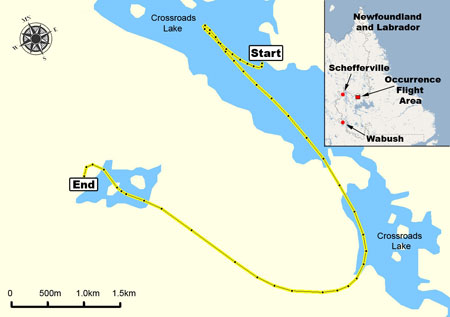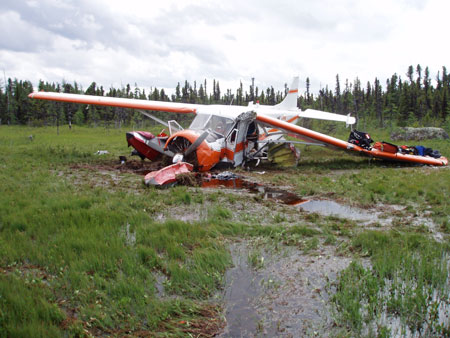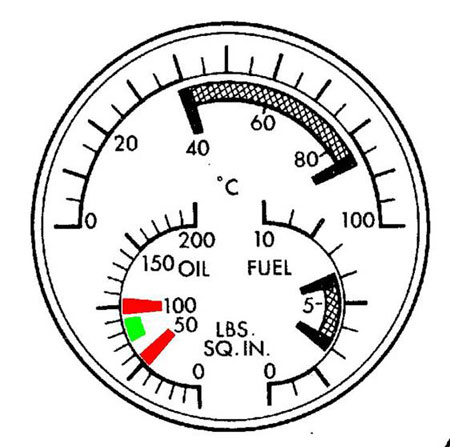Engine Failure and Collision with Terrain
Labrador Air Safari (1984) Inc.
de Havilland DHC-2 MK 1 (Beaver) C-FPQC
Schefferville, Quebec, 70 nm E
The Transportation Safety Board of Canada (TSB) investigated this occurrence for the purpose of advancing transportation safety. It is not the function of the Board to assign fault or determine civil or criminal liability. This report is not created for use in the context of legal, disciplinary or other proceedings. See Ownership and use of content. Masculine pronouns and position titles may be used to signify all genders to comply with the Canadian Transportation Accident Investigation and Safety Board Act (S.C. 1989, c. 3).
Summary
The Labrador Air Safari (1984) Inc. float-equipped de Havilland DHC-2 (Beaver) aircraft (registration C-FPQC, serial number 873) departed Crossroads Lake, Newfoundland and Labrador, at approximately 0813 Atlantic daylight time with the pilot and six passengers on board. About three minutes after take-off as the aircraft continued in the climb-out, the engine failed abruptly. When the engine failed, the aircraft was about 350 feet above ground with a ground speed of about 85 miles per hour. The pilot initiated a left turn and, shortly after, the aircraft crashed in a bog. The pilot and four of the occupants were seriously injured; two occupants received minor injuries. The aircraft was substantially damaged, but there was no post-impact fire. The impact forces activated the onboard emergency locator transmitter.
Factual information
The pilot was certified and qualified in accordance with existing regulations. The pilot started working for Labrador Air Safari (1984) Inc. in June 2008 and received the required company training on the Beaver. At the time of the occurrence flight, the pilot had accumulated a total of 7885 flying hours including approximately 1000 hours on the type. He had conducted 152 take-offs and landings in and around the occurrence area since starting in June 2008.
Records indicate that the aircraft was certified, equipped, and maintained in accordance with existing regulations and approved procedures. The weight and centre of gravity were within the prescribed limits.
On 12 July 2008 during a local flight, the engine oil pressure indication dropped below the normal 75 pounds per square inch (psi) and fluctuated between 50 and 75 psi. All other engine indications, including the oil quantity, were normal and the engine sounded normal. The pilot contacted the company's maintenance department and discussed the malfunction. It was suspected that the problem was due to a faulty oil pressure gauge. The aircraft was to be flown to Wabush, Newfoundland and Labrador, on 14 July 2008 to have the oil pressure gauge checked by maintenance. After consultation over the telephone, maintenance considered it safe to continue flying the aircraft with the gauge as is until it could be checked on 14 July 2008. The pilot made two short flights in the aircraft on 13 July 2008 for a total flight time of about one hour and during these flights the oil pressure indication remained between 50 and 75 psi. On the day of the occurrence, the pilot was scheduled to drop off four customers and two guides at two different nearby fishing sites before proceeding to Wabush.
There are no official weather reporting facilities near Crossroads Lake. Conditions over the general area on 14 July 2008 were visual meteorological conditions with good visibility and light winds from the southwest. The temperature was approximately 15°C.
A portable Garmin global positioning system (GPS), model GPS Map 296, was recovered from the aircraft. The stored data was downloaded and used to determine approximate flight path, heading, altitude, ground speed, and time of the occurrence.
The aircraft departed in a south-southeast direction, then turned to the right and rolled out on a northwest heading and continued to climb (see Figure 1).
Within two minutes, the engine briefly sputtered and then abruptly stopped. The pilot initially banked the aircraft to the right and then began a left turn towards a bog bordering a small pond that the aircraft had just flown over. Airspeed was steadily decreasing as the aircraft lost altitude and the rate of descent increased. During the left turn, the aircraft went through approximately a 130° change in heading before making contact with the bog.
Photographs of the aircraft wreckage, aircraft damage, and impact marks taken by various sources were analyzed to determine the impact geometry. On initial contact, the aircraft was approximately 30° nose down and in a left bank of approximately 30°.
The force at impact was enough to cause major structural damage to the engine mount, cowlings, left wing, and both floats. The cushioning effect of the bog prevented more serious damage and helped the Beaver rebound out of the initial impact point to the position shown in Photo 1. The impact forces were strong enough to cause serious injury to some passengers.
The aircraft was equipped with both lap straps and shoulder harnesses. The pilot was wearing only the available lap strap because he was not in the habit of using the shoulder harness. The pilot suffered serious head injuries. The regulatory requirements for the use of crew member safety beltsFootnote 1 are published in Canadian Aviation Regulations (CARs) subsection 605.27 (1). The CARs require the use of safety belts, in this case, during take-off and landing. Non-use of shoulder harnesses has been identified as a contributor to the severity of occupant injuries in numerous TSB investigation reports including reports A94P0231, A06W0104, A07P0209, A07Q0014, and A08A0007.
The aircraft was equipped with a NARCO Model 10 emergency locator transmitter, which activated during impact. A passenger used a satellite phone to contact the fishing lodge, which relayed the GPS co-ordinates to the Joint Rescue Coordination Centre.
The aircraft was recovered and transported to the operator's facility in Baie-Comeau, Quebec, where a TSB investigator examined the aircraft. It was determined that there were no anomalies with the integrity of the oil supply lines. The engine oil filter was removed and no debris was found. Approximately 4.5 gallons of oil were recovered from the engine and oil tank. When the engine crankcase sump drain plug was removed, a significant amount of metallic debris was found. The engine was shipped to the TSB Laboratory for disassembly and examination.
The aircraft was equipped with a Pratt & Whitney (P&W) R985 AN14B nine-cylinder radial engine, which had been overhauled and then installed on 23 May 2008.Footnote 2 The most recent overhaul was carried out by an approved facility on 28 April 2008; at the time of the accident the engine had about 88 hours of operation. A 100-hour inspection had been carried out on 04 July 2008, at which time the engine had accumulated about 71 flight hours. No discrepancies were noted with the engine oil system. During the inspection, the mineral oil that is used for engine break-in was drained and replenished with five gallons of Aeroshell W100 oil.Footnote 3
All the linkrods and linkpin bushings had failed at the master rod linkpin attachment end and all of these components exhibited evidence of lack of lubrication. The aluminum linkpin plugs (Part Number 39749),Footnote 4 normally installed in the linkpins to seal the oil passage and ensure proper lubrication of the crankshaft and associated components, were not installed in the linkpins nor were they found in the recovered debris. Metallurgical analysis of the recovered debris revealed no conclusive evidence as to the presence of any linkpin plug material. There were no significant traces of aluminum found in the threaded portion of the linkpins and there was no indication that the linkpin plugs had melted during engine operation or the catastrophic failure. The master rod bearing had extruded into and plugged the oil holes in the master rod and all eight oil holes in the master rod crankpin bearing were found blocked by bearing material. The blockage of these holes would have prevented oil from flowing from the crankpin, through the master rod, to the linkpins and linkpin bushings.
Engine documentation requires the minimum oil pressure to be 50 psi and the maximum oil pressure to be 100 psi. The engine data plate identifies the minimum oil pressure in cruise operation as 70 psi. The Beaver flight manual shows that the oil pressure operating range is between 50 and 100 psi, and 70 to 90 psi (green arc) for continuous rich mixture operation (see Figure 2). The flight manual states that in a yellow or cautionary range, "danger may exist under certain conditions." There are no yellow range markings on the oil pressure gauge. The flight manual does not provide any written instructions for the pilot as to what to do when the engine oil pressure is operating outside the green arc.
Aircraft manufacturers consider any instrument gauge green arc to be the normal operating range. However, industry practice for the Beaver aeroplane equipped with the P&W R985 indicates that the engine can be safely operated as long as the oil pressure is within the 50 to 100 psi range (between the two red arcs on the oil pressure gauge).
The Beaver flight manual indicates that the flaps-up stall speed is 60 mph and the flaps-landing stall speed is 45 mph. The flight manual emergency procedures state that if there is an engine failure immediately after take-off, the pilot should immediately lower the nose to maintain an airspeed of 65 mph, keep straight ahead, and change direction only enough to miss obstacles by using just the rudder. The flight manual also provides the following cautions:
- Always maintain enough airspeed to assure full control of aircraft to point of touchdown. Coarse use of ailerons near the stall airspeed precipitates wing dropping.
- It is better to ride an aircraft with a dead engine safely to a crash landing straight ahead than to turn back to the field. Attempts to turn back have, in many instances, ended with uncontrolled roll or spin into the ground.
This guidance in the Beaver flight manual is consistent with the pilot training standard as described in the Transport Canada Flight Training Manual,Footnote 5 which states the following in the generic procedure for an engine failure after take-off:
Lower the nose to maintain the glide speed. Land straight ahead, or alter course slightly to avoid obstacles
Regarding an attempt to turn back to a runway or landing area with insufficient altitude, the Flight Training Manual cautions pilots:
Numerous fatal accidents have resulted from attempting to turn back and land on the runway or aerodrome following an engine failure after take-off. As altitude is at a premium, the tendency is to try to hold the nose of the aircraft up during the turn without consideration for airspeed and load factor.
Analysis
During engine overhaul, the linkpin plugs had not been installed in the linkpins. Over the 90 hours since the engine was overhauled, the absence of the linkpin plugs allowed a reduced oil pressure at the master rod bearing and crankpin interface. This caused increased heat due to friction, accelerated wear, and smearing of the bearing material, resulting in the lack of lubrication to critical engine components.
With a normally running engine, oil circulating through the engine oil system is routed through the oil filter, capturing any debris or contaminants. During the engine examination, no debris was noted in the engine oil filter. This indicates that the engine failed catastrophically due to inadequate lubrication to the linkpin bushings.
The Beaver flight manual and flight training guidance states that a pilot must maintain a safe airspeed to assure full control of the aircraft by lowering the nose and landing straight ahead. During the forced approach the aircraft turned through approximately 130°; this decision was based on finding a more suitable landing area than the terrain located straight ahead of the aircraft.
During the turn, the aircraft's airspeed decreased and the aircraft entered an aerodynamic stall at a height where successful recovery was not possible. This resulted in a rapid descent and considerable impact with the bog. Had the pilot followed the guidance of the Beaver flight manual and proceeded straight ahead while maintaining a safe flying speed, the crash landing could possibly have been less violent.
Industry practice is such that the green arc (70 to 90 psi) on the oil pressure indicator is usually described as the safe operating range. However, the Beaver aeroplane equipped with the Pratt & Whitney R985 can be operated as long as the engine oil pressure is within the 50 to 100 psi range (between the red arcs on the indicator). This inconsistency with industry practice could lead to confusion and inadvertent landings if a pilot thought the oil pressure was too low while operating the engine out of the green arc.
Had the pilot worn the shoulder harness, it is likely that his injuries would have been less severe.
The following TSB Laboratory reports were completed:
- LP 115/2008 – Engine Teardown
- LP 116/2008 – GPS Download
These reports are available from the Transportation Safety Board upon request.
Findings
Findings as to causes and contributing factors
- The linkpin plugs had not been installed in the recently overhauled engine, causing inadequate lubrication to the linkpin bushings, increased heat, and eventually an abrupt engine failure.
- Immediately following the engine failure, while the pilot manoeuvred the aircraft for a forced landing, the aircraft entered an aerodynamic stall at a height from which recovery was not possible.
Finding as to Risk
- The failure to utilize available shoulder harnesses increases the risk and severity of injury.
This report concludes the Transportation Safety Board's investigation into this occurrence. Consequently, the Board authorized the release of this report on .


